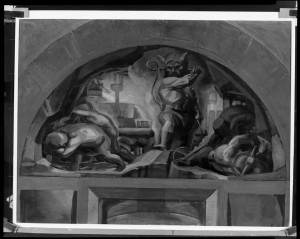
The Harvard Art Museums Archives recently completed a processing project, generously funded by The Getty Foundation and the Institute of Museum and Library Services (IMLS). In the process of cataloging its major holdings from 1895-present, the Archives has uncovered some wonderful documents. The following represents material found during this project.
Painter, educator and muralist, Lewis Rubenstein attended Harvard University (class of 1930), and later became professor of painting at Vassar College in 1939. He was commissioned to create murals by the Busch-Reisinger Museum and the Fogg Museum at Harvard, as well as the Jewish Center in Buffalo, N.Y., and the Wareham, Mass. Post Office for the WPA’s Section of Fine Arts in 1940.
The murals painted in the (now) Busch-Reisinger Museum in 1930 proved to be quite controversial. The murals, unveiled in 1937, portray characters Niebelung and Ragnarok of German legend. According to the artist, the characters in the murals are depicted in modern accessories to show the current threat to world peace for that time: fascism. Rubenstein stressed that the murals were, “frescos based on Germanic/Norse legends and used to make commentary on world events not to represent any specific figures.”
The Germanic legend called the Nibelungenlied or “The Song of the Nibelungs” is an epic poem written in Middle High German. It is a four-part story of heroic motifs about a dragon slayer whose death is avenged. The two main characters, Niebelung and Ragnarok are depicted in Rubenstein’s work.This October 31, 1935 article from The Crimson describes the controversial nature of the work. Many people felt that Rubenstein’s mural was a political commentary on Germany’s Socialist regime because the Nazi invasion of Poland occurred two years prior to the unveiling. To many, the mural itself was considered an “insult to the leader of foreign nation.”
The murals were covered by paneling from 1964 until 1980, when Rubenstein requested it be removed in honor of his 50th class reunion.

